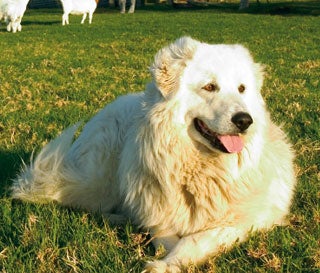Learn about dog breeds
Detailed information & photos on over 190 different breeds
Description
The Maremma Sheepdog is a large dog bred for sheepherding. Though he is smaller than most other breeds of working dogs, he is still an excellent choice as a working dog.
The Maremma Sheepdog is all white and has lots of long fluffy fur. He does not do well in summer months or in warm or hot climates as he was originally bred to be a working dog in the mountains.
Coat Description
The Maremma Sheepdog has a very thick white coat with a very thick undercoat. This undercoat is made to keep the dog warm in the winter and cool in the summer, so it is important not to trim the dog's fur in the summer. His coat can become matted when it is wet. He sheds a lot during warmer months.
The Maremma Sheepdog is usually all white or ivory with a black or dark brown collared nose. He has few is any markings.
History
Originally there were two different types of Maremma Sheepdogs. One was bred to be used in higher altitudes, and the other was for use in lower altitudes. However, the two types have been merged into the one type common today. The dog was originally bred in the Apennine Mountains in Italy. He was bred for use as a herder in mountain villages. He may be related to other types of Europe's most famous mountain dog breeds, and is possibly a descendent of Roman herders. He was brought to the United States in the 1970s, but is still more common in Europe and the United Kingdom.
Temperament
The Maremma Sheepdog is a fierce defender of his flock or his family. He is very loyal and extremely smart. He was bred for his environmental endurance, and is a strong animal. Because he was originally bred to be a herder or a guard dog, he has a tendency to be defensive, though he is not aggressive. He will herd his family members, and will often paw at them, lean on them, or nudge them to get them to go one way or another. He is quite stubborn and therefore hard to train. He is smart enough to know how to act in work situations, but will be defiant against an owner if he does not want to obey.
Health Problems
The Maremma Sheepdog does not have any of the typical congenital diseases or disorders that are usually found in large breed dogs. He can have some joint problems, though these are usually due to weight problems. He can also fall victim to bloat, a disorder of the stomach caused by too much food consumed too quickly. Both of these last two problems can be addressed by a veterinarian; the usual remedy is to put the dog on a lighter calorie diet.
Grooming
Maremma Sheepdogs need to be groomed regularly. Because of their exceptionally thick coats and large amount of fur, they need to be brushed at least one time a day, maybe twice. Their fur tangles easily and must be thoroughly combed. The dog sheds a lot, particularly in warmer months of spring and summer. During this time, he needs to be brushed twice as often. If he lives outside, he does not need to have his claws trimmed, through his dewclaws must be checked to prevent in growth. He also needs to be checked regularly for fleas and ticks.
Exercise
The Maremma Sheepdog needs to have his needs met, and most of these needs are physical. He must have freedom to roam around large expanses of land. It is not appropriate to just walk him every day on a leash the way one might with another large breed dog. Even running with him for a few miles each day will not use up all of the dog's energy or satisfy his need to constantly roam. The Maremma needs constant exercise and a job to occupy his time and surplus energy.
Training
For the first two years of the dog's life, he needs to be prepped for life as a working dog. He needs to have specific training for either herding or for guarding. In general, it takes about two years to train a Maremma Sheepdog as a herding dog. If the dog is intended as a house pet, he is easy to potty train. He does need a lot of socialization with other animals and people in order to behave correctly as a pet. He should be monitored constantly in a yard because he does tend to run away. The dog is notoriously hard to train because of his stubbornness and is better kept as a working dog than as a pet.
Advertise | Privacy Policy | Terms of Use | Contact Us © Copyright 2004-2024 PupCity.com. All rights reserved.
